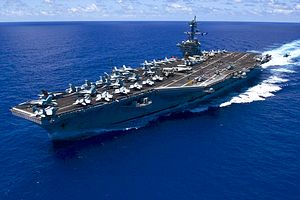This month, the United States Navy made another stride in its quest toward unmamed carrier aviation by installing the first unmanned aerial vehicle (UAV) command center aboard the Nimitz-class supercarrier USS Carl Vinson, according to a U.S. Navy press release.
“This marks the start of a phased implementation of the MQ-XX system on an aircraft carrier,” said Captain Beau Duarte, the program manager of the U.S. Navy’s Unmanned Carrier Aviation program office “The lessons learned and ground-breaking work done here will go on to inform and influence future installations on other aircraft carriers.”
The MQ-XX is a planned high-endurance drone specifically designed for aerial refueling as well as intelligence, surveillance, and reconnaissance missions (ISR). It is meant to replace the F/A-18E/F aircraft in its role as the aerial tanker for the air wing of an aircraft carrier.
The MQ-XX is slated to be operational in the 2020s and will purportedly not have a long-range strike capability initially, although some U.S. lawmakers have recently stated that they want the new drone to have an attack capability right from its induction date.
The U.S. Navy’s Director of Air Warfare, Rear Admiral Mike Manazir, told U.S. lawmakers that the reason why the Navy is focusing on aerial refueling and ISR rather than weaponizing the drone is that it “can accommodate those two missions on an unmanned system coming off the aircraft carrier more rapidly,” according to USNI News.
“We got everything out of that platform that we need, now what we’ve got to do is show we can use a platform to do two basic meat-and-potato missions on the aircraft carrier using the MQ-XX,” Manazir added. “And that will also provide a platform for us to go forward and do additional more advanced capabilities in the future.”
Construction of the new drone command aboard the USS Carl Vinson is slated to be completed by 2022. “We are carving out precious real estate on board the carrier, knowing that the carrier of the future will have manned and unmanned systems on it,” said Captain Karl Thomas, the USS Carl Vinson’s commanding officer.
“This suite is an incremental step necessary to extend performance, efficiency and enhance safety of aerial refueling and reconnaissance missions that are expending valuable flight hours on our strike-fighter aircraft, the F/A-18 Echoes and Foxtrots.”
The overall commander of the Carrier Strike Group, Rear Admiral Rear Admiral James Loeblein said that “having a UAV asset that provides persistent, potentially 24/7, surveillance coverage for the strike group is a game changer. Putting additional ISR capacity into the warfare commander’s hands increases the flexibility and warfare capability of the entire strike group.”

































